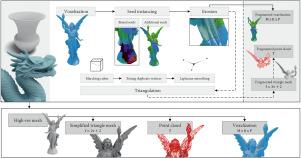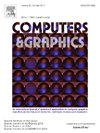为机器学习生成隐含对象片段数据集
IF 2.5
4区 计算机科学
Q2 COMPUTER SCIENCE, SOFTWARE ENGINEERING
引用次数: 0
摘要
利用深度学习模型固有的主要挑战之一,是获取足够规模的数据集以促进这些网络的有效训练所面临的稀缺性和可访问性障碍。这一点在物体检测、形状补全和断裂组装方面尤为突出。与其扫描现实世界中的大量碎片,不如用合成碎片生成海量数据集。然而,现实中的碎片在准备(如预制模型)和生成过程中需要大量计算。否则,Voronoi 图等更简单的算法可以提供更快的处理速度,但却牺牲了真实性。在这种情况下,需要在计算效率和真实度之间取得平衡。本文介绍了一种基于 GPU 的框架,用于大规模生成源自高分辨率三维模型的体素化片段,专门用作机器学习模型的训练集。这种快速管道可以控制生成碎片的数量、碎片的分散以及侵蚀等微妙效果的出现。我们用一个考古数据集测试了我们的管道,从 1052 件伊比利亚船只中生成了 100 多万件碎片(Github)。虽然这项工作的主要目的是提供由体素表示的隐式数据碎片,但三角网格和点云也可以从初始隐式表示中推断出来。为了强调 CPU 和 GPU 加速在生成庞大数据集方面的无与伦比的优势,我们与一个现实的片段生成器进行了比较,以突出我们的方法在适用性和处理时间方面的潜力。我们还展示了我们的管道与现实模拟器之间的协同效应,现实模拟器通常无法选择生成片段的数量和大小。为此,我们在现实碎片和我们的数据集上训练了一个深度学习模型,显示了类似的结果。本文章由计算机程序翻译,如有差异,请以英文原文为准。

Generating implicit object fragment datasets for machine learning
One of the primary challenges inherent in utilizing deep learning models is the scarcity and accessibility hurdles associated with acquiring datasets of sufficient size to facilitate effective training of these networks. This is particularly significant in object detection, shape completion, and fracture assembly. Instead of scanning a large number of real-world fragments, it is possible to generate massive datasets with synthetic pieces. However, realistic fragmentation is computationally intensive in the preparation (e.g., pre-factured models) and generation. Otherwise, simpler algorithms such as Voronoi diagrams provide faster processing speeds at the expense of compromising realism. In this context, it is required to balance computational efficiency and realism. This paper introduces a GPU-based framework for the massive generation of voxelized fragments derived from high-resolution 3D models, specifically prepared for their utilization as training sets for machine learning models. This rapid pipeline enables controlling how many pieces are produced, their dispersion and the appearance of subtle effects such as erosion. We have tested our pipeline with an archaeological dataset, producing more than 1M fragmented pieces from 1,052 Iberian vessels (Github). Although this work primarily intends to provide pieces as implicit data represented by voxels, triangle meshes and point clouds can also be inferred from the initial implicit representation. To underscore the unparalleled benefits of CPU and GPU acceleration in generating vast datasets, we compared against a realistic fragment generator that highlights the potential of our approach, both in terms of applicability and processing time. We also demonstrate the synergies between our pipeline and realistic simulators, which frequently cannot select the number and size of resulting pieces. To this end, a deep learning model was trained over realistic fragments and our dataset, showing similar results.
求助全文
通过发布文献求助,成功后即可免费获取论文全文。
去求助
来源期刊

Computers & Graphics-Uk
工程技术-计算机:软件工程
CiteScore
5.30
自引率
12.00%
发文量
173
审稿时长
38 days
期刊介绍:
Computers & Graphics is dedicated to disseminate information on research and applications of computer graphics (CG) techniques. The journal encourages articles on:
1. Research and applications of interactive computer graphics. We are particularly interested in novel interaction techniques and applications of CG to problem domains.
2. State-of-the-art papers on late-breaking, cutting-edge research on CG.
3. Information on innovative uses of graphics principles and technologies.
4. Tutorial papers on both teaching CG principles and innovative uses of CG in education.
 求助内容:
求助内容: 应助结果提醒方式:
应助结果提醒方式:


